
9 Sep 2024
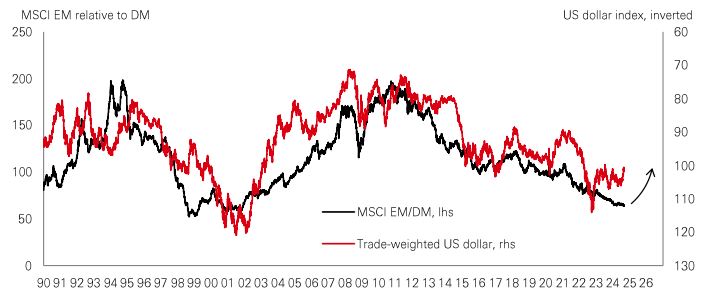
Risk assets have broadly recovered from August’s sharp sell-off, but not all market moves have unwound. On evidence of cooling US economic activity and lower inflation, traders now expect 1.25% of Fed rate cuts by the end of 2024 – up from the one to two cuts expected in early summer – and that is putting pressure on the US dollar.
Dollar weakness opens the door for other central banks to ease policy, to support their domestic economies.
So far, ASEAN has been the region to watch. A weaker dollar, the region’s high sensitivity to Fed policy, and ongoing disinflation, have set the scene for cuts. The Philippines central bank went first in August (reducing rates by 0.25%, and some analysts think Bank Indonesia could soon follow. While there is divergence across the region, ASEAN countries like Indonesia benefit from a resilient macro backdrop, reasonable asset valuations and structural tailwinds like favourable demographics and supportive industrial policies. They’ve also been shielded from the volatility in global technology stocks and resisted the impact of strong moves in the Japanese Yen.
Investors are reacting to this. ASEAN saw one of the strongest performances in global equities in August, and quarter-to-date – led by the Philippines, Indonesia, and Malaysia. But other EM regions are in the mix, too. Emerging Europe and Frontier regions have also done well. And while not all EMs have yet benefitted, a ‘great rotation’ in performance could continue to see a pick-up for the laggards.
Hong Kong’s Hang Seng index (HSI) delivered a solid performance in August, rising by around 4%. With earnings season ongoing, the index’s technology stocks (which include HK-listed mainland Chinese firms) have mostly beaten consensus. They are benefitting from resilient demand for tech services, overseas expansion which has boosted revenues, and recent mainland Chinese policy support for the sector – given its status as a national growth priority.
Excluding mainland Chinese tech stocks, Hong Kong’s domestic firms also performed well in August. The MSCI HK index – a close gauge of the market’s domestic stocks – rose 5.3%. Those firms are now seeing a pick-up in earnings estimates, helped by the prospect of imminent US rate cuts, and an improving outlook for non-cyclical sectors like utilities and consumer staples. That said, the downtrend in earnings for domestic stocks since mid-2022 has not yet reversed, with macro challenges still weighing on sectors like financials and real estate. With mainland China’s largely domestic onshore stock market losing more ground in August, some analysts think the HSI could continue to outperform this year given its appealing valuation and superior growth outlook.
The value of investments and any income from them can go down as well as up and investors may not get back the amount originally invested. Past performance does not predict future returns. The level of yield is not guaranteed and may rise or fall in the future.
This information shouldn't be considered as a recommendation to buy or sell specific sector/stocks mentioned. Any views expressed were held at the time of preparation and are subject to change without notice. While any forecast, projection or target where provided is indicative only and not guaranteed in any way. Source: HSBC Asset Management. Macrobond, Bloomberg. Data as at 11.00am UK time 06 September 2024.
What do rock legends AC/DC know about the US bond market? …they know the yield curve is ‘Back in Black’.
The US yield curve – which plots the relationship between two- and 10-year Treasury yields – has been inverted since March 2022. Last week’s dis-inversion – with the curve moving back into the black – shouldn’t really surprise us. After all, short-term bond yields have fallen quickly over the summer, as expectations for Fed cuts have grown.
But what’s concerning is that a dis-inverting yield curve, driven by ‘bull steepening’ (when the short end of the curve falls faster than the long end) is a robust leading indicator of recession. Even if the yield curve is just a ‘mirror’, reflecting the bond market’s best guess about future interest rates, it looks like an important cyclical change is underway as growth and labour market data cool quickly. That should put investors on alert. The most important thing to watch now is how far – and how fast – the curve steepens. A gradual steepening toward a normal, say +0.5% slope, would be fully consistent with a soft landing, and a broadening out pattern in stock markets.
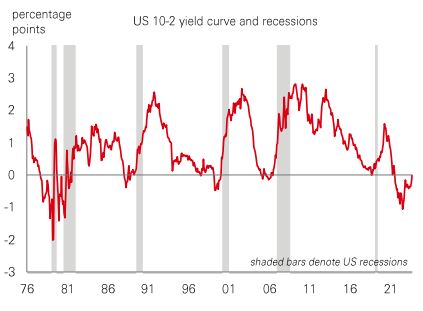
Private equity activity has been sluggish since mid-2022 – demanding caution on the part of investors. But green shoots of recovery and a pick-up in investment deal-making could signal a turning point.
On a like-for-like basis with other asset classes, we measure private equity expected returns in the low teens today. That reflects a sizeable equity and illiquidity premium. For an easy frame of reference, it converts to an internal rate of return (IRR) – a measure of investment profitability – of around 20%. These returns look attractive and, with valuations now lower after 2021-22 inflation burst and rapid policy tightening, we may be seeing the start of an interesting entry point for longer-term investors.
Some headwinds remain for the asset class, however. Exit markets (where investments are sold) remain mixed; data suggest that exit values are improving, but it is difficult to see a strong bounce back in sentiment or activity levels. During the last quarter, exits were just 36% of investments and suggests that the market has still not found its equilibrium.
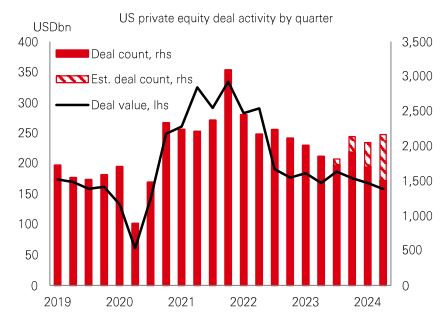
The world is undergoing profound change as globalisation decelerates. It’s useful to examine this shift through three power clusters: the global West, the global East, and the global South. In simple terms, the West wants to preserve the current world order, the East aims to take the lead by presenting an alternative to the West’s hegemonic order, and the South operates as a collective system or ‘swing cluster’ capable of ‘swinging’ to the West or East depending on its interests.
Amid this power competition, new opportunities arise for investors in frontier and emerging markets. Moves by the West and East to reduce their economic interdependence imply a realignment of supply chains via ‘friendshoring’ and ‘nearshoring’. This benefits many economies in the South, such as Mexico, India, and Southeast Asia.
And by sector, capital equipment, semiconductors and electric vehicle batteries are well positioned to grow rapidly as East-West tensions persist. India’s nascent semiconductor industry – with a total of USD15bn of investment in chipmaking plants announced earlier this year – is a good example. So as these shifting dynamics continue to reshape the global economic landscape, it’ll be key for investors to stay attuned.
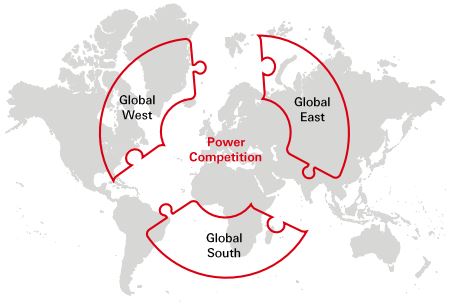
Past performance does not predict future returns. The level of yield is not guaranteed and may rise or fall in the future. This information shouldn't be considered as a recommendation to buy or sell specific sector/stocks mentioned. Any views expressed were held at the time of preparation and are subject to change without notice. Source: HSBC Asset Management. Macrobond, Bloomberg, Datastream. Data as at 11.00am UK time 06 September 2024.
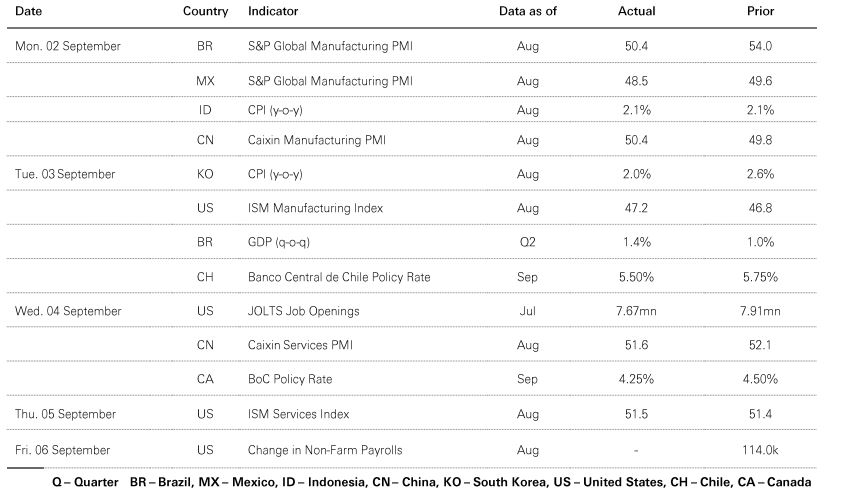
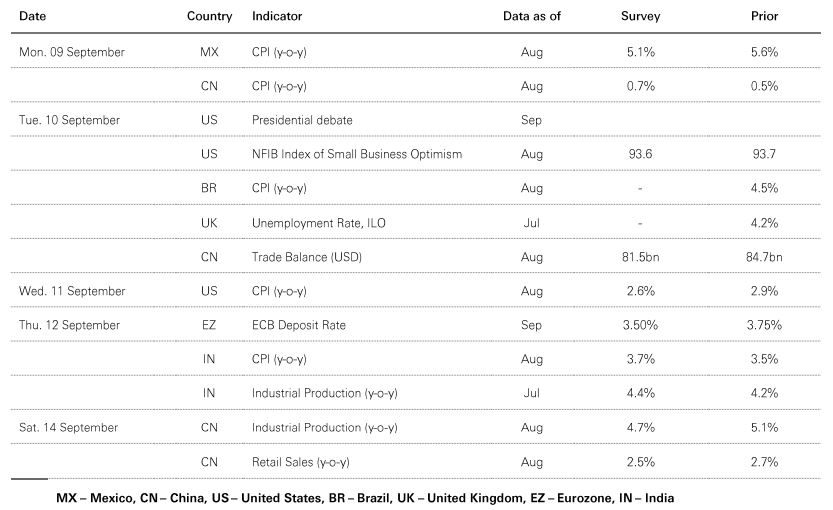
Source: HSBC Asset Management. Data as at 11.00am UK time 06 September 2024. This information shouldn't be considered as a recommendation to buy or sell specific sector/stocks mentioned. Any views expressed were held at the time of preparation and are subject to change without notice.
Mounting fears of a possible US hard landing cast a pall over risk markets. Core government bonds rallied, with the US yield curve dis-inverting for the first time since 2022 amid a re-pricing of US rate expectations. The Bank of Canada cut rates by 0.25% for the third consecutive meeting, with attention now turning to the European Central Bank’s Council meeting this week. Elsewhere, the US DXY dollar index resumed its downward trend, and there was continued weakness in US technology equities, with cautious sentiment spilling into European and Japanese stock markets. EM equities largely weakened, led by Korea’s tech-dominant Kospi index. Mainland China’s Shanghai composite index fell amid continued macro concerns, while Thailand’s SE index rallied. In commodities, demand worries drove oil prices to 2024 lows, and copper also weakened. Gold consolidated after recent gains.





This document or video is prepared by The Hongkong and Shanghai Banking Corporation Limited (‘HBAP’), 1 Queen’s Road Central, Hong Kong. HBAP is incorporated in Hong Kong and is part of the HSBC Group. This document or video is distributed and/or made available, HSBC Bank (China) Company Limited, HSBC Bank (Singapore) Limited, HSBC Bank Middle East Limited (UAE), HSBC UK Bank Plc, HSBC Bank Malaysia Berhad (198401015221 (127776-V))/HSBC Amanah Malaysia Berhad (20080100642 1 (807705-X)), HSBC Bank (Taiwan) Limited, HSBC Bank plc, Jersey Branch, HSBC Bank plc, Guernsey Branch, HSBC Bank plc in the Isle of Man, HSBC Continental Europe, Greece, The Hongkong and Shanghai Banking Corporation Limited, India (HSBC India), HSBC Bank (Vietnam) Limited, PT Bank HSBC Indonesia (HBID), HSBC Bank (Uruguay) S.A. (HSBC Uruguay is authorised and oversought by Banco Central del Uruguay), HBAP Sri Lanka Branch, The Hongkong and Shanghai Banking Corporation Limited – Philippine Branch, HSBC Investment and Insurance Brokerage, Philippines Inc, and HSBC FinTech Services (Shanghai) Company Limited and HSBC Mexico, S.A. Multiple Banking Institution HSBC Financial Group (collectively, the “Distributors”) to their respective clients. This document or video is for general circulation and information purposes only.
The contents of this document or video may not be reproduced or further distributed to any person or entity, whether in whole or in part, for any purpose. This document or video must not be distributed in any jurisdiction where its distribution is unlawful. All non-authorised reproduction or use of this document or video will be the responsibility of the user and may lead to legal proceedings. The material contained in this document or video is for general information purposes only and does not constitute investment research or advice or a recommendation to buy or sell investments. Some of the statements contained in this document or video may be considered forward looking statements which provide current expectations or forecasts of future events. Such forward looking statements are not guarantees of future performance or events and involve risks and uncertainties. Actual results may differ materially from those described in such forward-looking statements as a result of various factors. HBAP and the Distributors do not undertake any obligation to update the forward-looking statements contained herein, or to update the reasons why actual results could differ from those projected in the forward-looking statements. This document or video has no contractual value and is not by any means intended as a solicitation, nor a recommendation for the purchase or sale of any financial instrument in any jurisdiction in which such an offer is not lawful. The views and opinions expressed are based on the HSBC Global Investment Committee at the time of preparation and are subject to change at any time. These views may not necessarily indicate HSBC Asset Management‘s current portfolios’ composition. Individual portfolios managed by HSBC Asset Management primarily reflect individual clients’ objectives, risk preferences, time horizon, and market liquidity.
The value of investments and the income from them can go down as well as up and investors may not get back the amount originally invested. Past performance contained in this document or video is not a reliable indicator of future performance whilst any forecasts, projections and simulations contained herein should not be relied upon as an indication of future results. Where overseas investments are held the rate of currency exchange may cause the value of such investments to go down as well as up. Investments in emerging markets are by their nature higher risk and potentially more volatile than those inherent in some established markets. Economies in emerging markets generally are heavily dependent upon international trade and, accordingly, have been and may continue to be affected adversely by trade barriers, exchange controls, managed adjustments in relative currency values and other protectionist measures imposed or negotiated by the countries with which they trade. These economies also have been and may continue to be affected adversely by economic conditions in the countries in which they trade. Investments are subject to market risks, read all investment related documents carefully.
This document or video provides a high-level overview of the recent economic environment and has been prepared for information purposes only. The views presented are those of HBAP and are based on HBAP’s global views and may not necessarily align with the Distributors’ local views. It has not been prepared in accordance with legal requirements designed to promote the independence of investment research and is not subject to any prohibition on dealing ahead of its dissemination. It is not intended to provide and should not be relied on for accounting, legal or tax advice. Before you make any investment decision, you may wish to consult an independent financial adviser. In the event that you choose not to seek advice from a financial adviser, you should carefully consider whether the investment product is suitable for you. You are advised to obtain appropriate professional advice where necessary.
The accuracy and/or completeness of any third-party information obtained from sources which we believe to be reliable might have not been independently verified, hence Customer must seek from several sources prior to making investment decision.
The following statement is only applicable to HSBC Mexico, S.A. Multiple Banking Institution HSBC Financial Group with regard to how the publication is distributed to its customers: This publication is distributed by Wealth Insights of HSBC México, and its objective is for informational purposes only and should not be interpreted as an offer or invitation to buy or sell any security related to financial instruments, investments or other financial product. This communication is not intended to contain an exhaustive description of the considerations that may be important in making a decision to make any change and/or modification to any product, and what is contained or reflected in this report does not constitute, and is not intended to constitute, nor should it be construed as advice, investment advice or a recommendation, offer or solicitation to buy or sell any service, product, security, merchandise, currency or any other asset.
Receiving parties should not consider this document as a substitute for their own judgment. The past performance of the securities or financial instruments mentioned herein is not necessarily indicative of future results. All information, as well as prices indicated, are subject to change without prior notice; Wealth Insights of HSBC Mexico is not obliged to update or keep it current or to give any notification in the event that the information presented here undergoes any update or change. The securities and investment products described herein may not be suitable for sale in all jurisdictions or may not be suitable for some categories of investors.
The information contained in this communication is derived from a variety of sources deemed reliable; however, its accuracy or completeness cannot be guaranteed. HSBC México will not be responsible for any loss or damage of any kind that may arise from transmission errors, inaccuracies, omissions, changes in market factors or conditions, or any other circumstance beyond the control of HSBC. Different HSBC legal entities may carry out distribution of Wealth Insights internationally in accordance with local regulatory requirements.
Important Information about the Hongkong and Shanghai Banking Corporation Limited, India (“HSBC India”)
HSBC India is a branch of The Hongkong and Shanghai Banking Corporation Limited. HSBC India is a distributor of mutual funds and referrer of investment products from third party entities registered and regulated in India. HSBC India does not distribute investment products to those persons who are either the citizens or residents of United States of America (USA), Canada, Australia or New Zealand or any other jurisdiction where such distribution would be contrary to law or regulation.
The following statement is only applicable to HSBC Bank (Taiwan) Limited with regard to how the publication is distributed to its customers: HSBC Bank (Taiwan) Limited (“the Bank”) shall fulfill the fiduciary duty act as a reasonable person once in exercising offering/conducting ordinary care in offering trust services/ business. However, the Bank disclaims any guarantee on the management or operation performance of the trust business.
The following statement is only applicable to PT Bank HSBC Indonesia (“HBID”): PT Bank HSBC Indonesia (“HBID”) is licensed and supervised by Indonesia Financial Services Authority (“OJK”). Customer must understand that historical performance does not guarantee future performance. Investment product that are offered in HBID is third party products, HBID is a selling agent for third party product such as Mutual Fund and Bonds. HBID and HSBC Group (HSBC Holdings Plc and its subsidiaries and associates company or any of its branches) does not guarantee the underlying investment, principal or return on customer investment. Investment in Mutual Funds and Bonds is not covered by the deposit insurance program of the Indonesian Deposit Insurance Corporation (LPS).
Important information on ESG and sustainable investing
Today we finance a number of industries that significantly contribute to greenhouse gas emissions. We have a strategy to help our customers to reduce their emissions and to reduce our own. For more information visit www.hsbc.com/sustainability.
In broad terms “ESG and sustainable investing” products include investment approaches or instruments which consider environmental, social, governance and/or other sustainability factors to varying degrees. Certain instruments we classify as sustainable may be in the process of changing to deliver sustainability outcomes. There is no guarantee that ESG and Sustainable investing products will produce returns similar to those which don’t consider these factors. ESG and Sustainable investing products may diverge from traditional market benchmarks. In addition, there is no standard definition of, or measurement criteria for, ESG and Sustainable investing or the impact of ESG and Sustainable investing products. ESG and Sustainable investing and related impact measurement criteria are (a) highly subjective and (b) may vary significantly across and within sectors.
HSBC may rely on measurement criteria devised and reported by third party providers or issuers. HSBC does not always conduct its own specific due diligence in relation to measurement criteria. There is no guarantee: (a) that the nature of the ESG / sustainability impact or measurement criteria of an investment will be aligned with any particular investor’s sustainability goals; or (b) that the stated level or target level of ESG / sustainability impact will be achieved. ESG and Sustainable investing is an evolving area and new regulations are being developed which will affect how investments can be categorised or labelled. An investment which is considered to fulfil sustainable criteria today may not meet those criteria at some point in the future.
THE CONTENTS OF THIS DOCUMENT OR VIDEO HAVE NOT BEEN REVIEWED BY ANY REGULATORY AUTHORITY IN HONG KONG OR ANY OTHER JURISDICTION. YOU ARE ADVISED TO EXERCISE CAUTION IN RELATION TO THE INVESTMENT AND THIS DOCUMENT OR VIDEO. IF YOU ARE IN DOUBT ABOUT ANY OF THE CONTENTS OF THIS DOCUMENT OR VIDEO, YOU SHOULD OBTAIN INDEPENDENT PROFESSIONAL ADVICE.
© Copyright 2024. The Hongkong and Shanghai Banking Corporation Limited, ALL RIGHTS RESERVED.
No part of this document or video may be reproduced, stored in a retrieval system, or transmitted, on any form or by any means, electronic, mechanical, photocopying, recording or otherwise, without the prior written permission of The Hongkong and Shanghai Banking Corporation Limited.